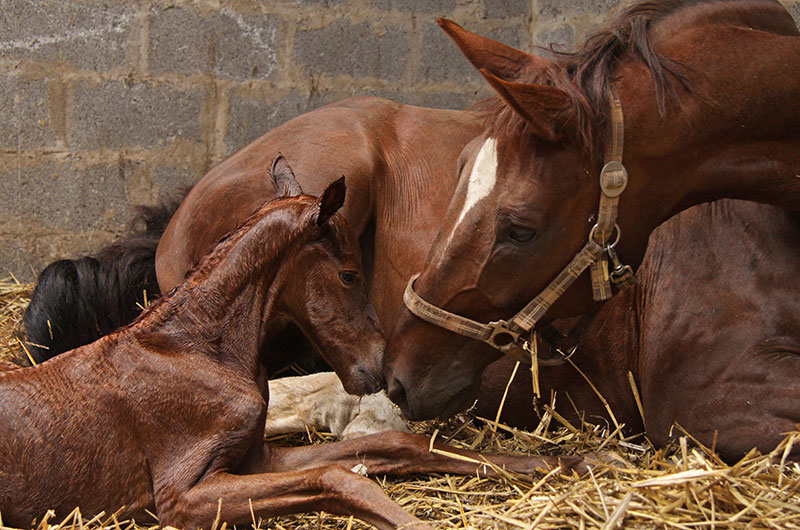Springtime is foaling season, the busiest time of year for equine veterinarians. In any species, births carry risks for mother and baby, and that holds true for horses. Complications during birth may lead to other difficulties for the newborn.

Dr. Pamela Wilkins, who is board certified in large animal internal medicine and in veterinary emergency and critical care, has written textbooks and lectured around the world on respiratory and cardiovascular problems in the critical foal. She describes signs that indicate a foal needs emergency critical care.
Foaling and Dystocia
Dystocia means complications during the birthing process. Normally, mares deliver their foals very quickly. “Once the ‘water’ breaks, the foal should be out in about 20 minutes,” says Dr. Wilkins. “If not, that foal is very much at risk for significant problems and death.”
According to Dr. Wilkins, every 10-minute interval past this 20-minute mark indicate a sharp increase in the risk of death of the foal. Therefore, dystocia is a medical emergency.
“If the birth takes too long, the foal can actually suffocate while in the uterus, because the placenta that had been delivering oxygen to the foal has detached from the mother,” Dr. Wilkins says. “Foals can also develop bacterial, fungal, or viral infections while in the uterus.”
Responding to Dystocia
Dystocia could have several causes. For example, the foal should be positioned so that its front feet and nose are the first parts to emerge from the mare. Any other position—hind legs first or with its back toward the cervix—signals trouble. The mare’s reproductive organs may present problems too if any abnormalities arise.
Unfortunately, Dr. Wilkins says there are no sure-fire ways to prevent dystocia. Early detection of dystocia and rapid response give the foal and the mare their best chance at survival. For this reason, Dr. Wilkins strongly recommends having trained personnel on hand to watch for and recognize the signs of dystocia.
“Recognizing early signs of placental/in utero infection, such as early onset lactation, can help us quickly identify infections in the mare in order to initiate treatment,” she says. Additionally, she recommends that mares have an appropriate, up-to-date vaccination status as recommended by the primary veterinarian.
How to Recognize Critical Foals
Recognition of foals in need of critical care is especially important if the birth was not actually witnessed. The birthing process may have taken longer than normal, and rapid medical response may be needed. A disruption of normal foal behavior, such as sleeping, nursing, and urinating, indicates that something is wrong with the foal.
“Newborn foals should be up and nursing by 2 to 3 hours after foaling,” Dr. Wilkins states. “Any foal that appears to be weakening, not nursing well, or not recognizing its mother should be quickly seen by a veterinarian as an emergency visit.”
Critical Care for Foals at University of Illinois
If foals are brought to the University of Illinois Veterinary Teaching Hospital, clinicians often recommend that the mares be brought along too. The bond between mare and foal is important, especially at such an early age.
“We try to keep the mare and foal together if possible,” explains Dr. Wilkins. “We have some barriers that we can use to ‘cage’ the foal for treatment, especially if they are on continuous IV fluids or if they need to be on a foal bed.
“That way mom can sniff and see the baby. We also use milk from the mare to feed the foal. This helps the mare recognize the foal as her own.”
After the foal’s condition has been stabilized and released from the hospital, owners should follow discharge instructions and attend follow-up visits with the primary veterinarian.
“Make sure the foal receives regular vaccinations and deworming as needed,” Dr. Wilkins adds.
At the Veterinary Teaching Hospital, foals receive care not just from the veterinary team but also from members of the veterinary student foal care team. These include first- through fourth-year veterinary students who volunteer for two-hour or overnight on-call shifts to aid doctors in the treatment and stabilization of the foal. “We are very grateful for their assistance,” Dr. Wilkins says. “It takes a village to take care of these sick babies!”
By Lauren Bryan
Feature photo by Fred Zwicky




